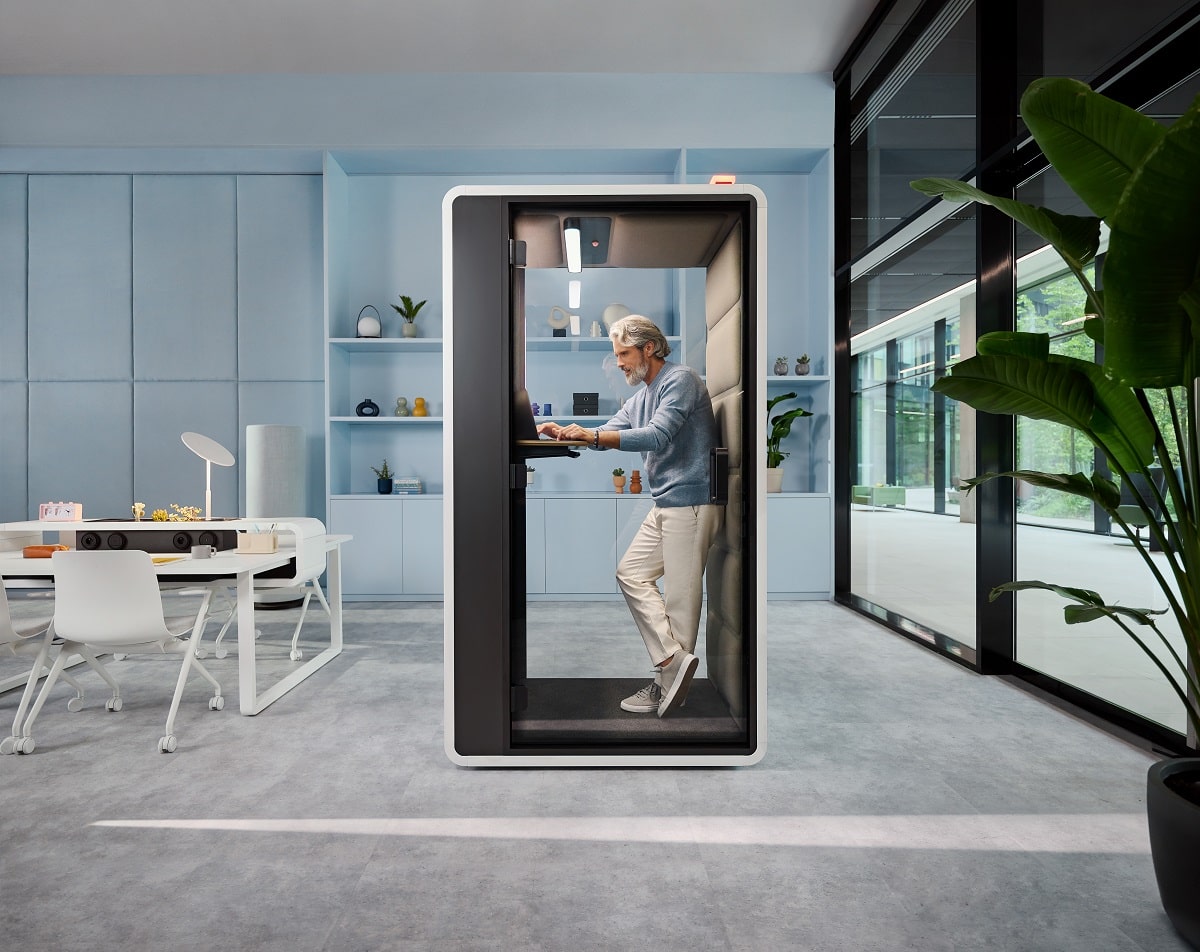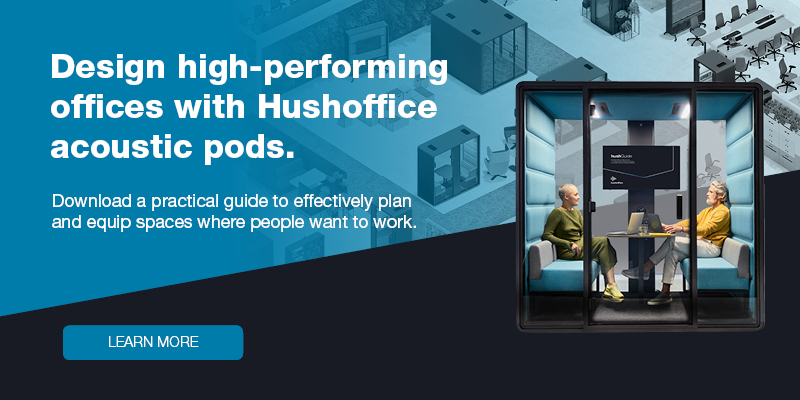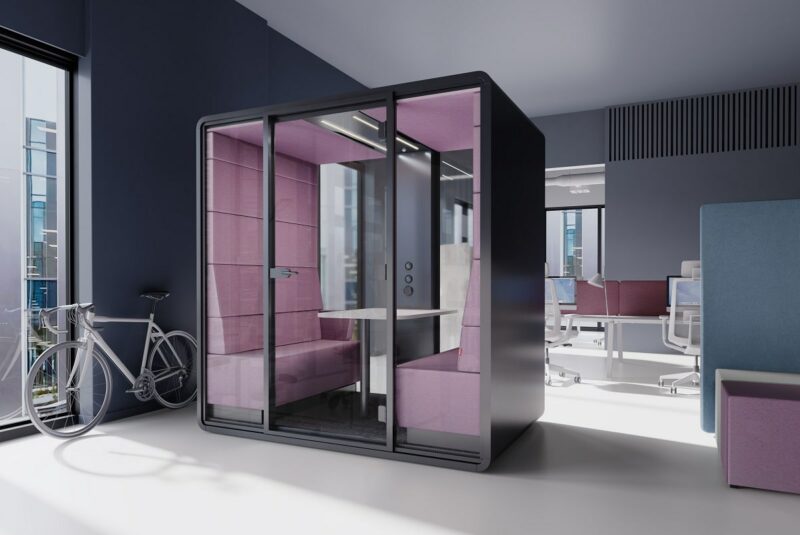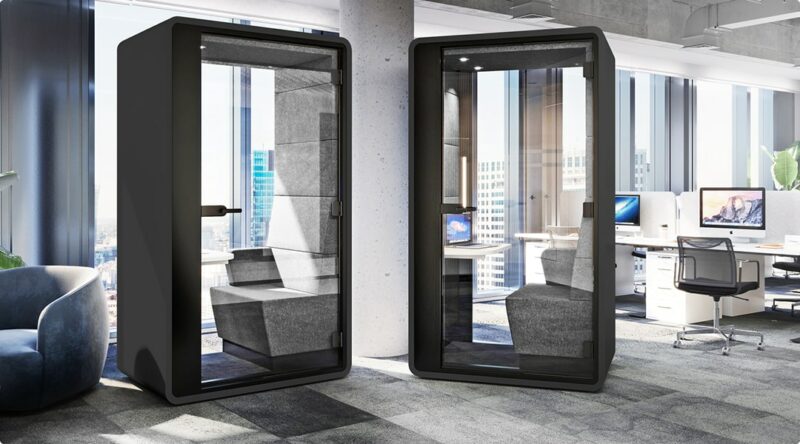Making space in the office for multilingual meetings
- Posted on: 17 September 2024
- By: Hushoffice Team
Global companies depend on bilingual employees. But speaking in a second language is inherently challenging. And it is made especially challenging by the office’s notorious blend of acoustic and visual distractions. Might acoustic meeting pods be the solution for you?
Multilingual meetings – tl;dr
- Multilingual employees are integral to an international company’s business. They lead quality dialogue, allow for attentive customer service, and bridge gaps within global teams. However, speaking a foreign language is always difficult due to factors like fear of judgment, difficulty expressing nuances, and mental exhaustion.
- Distractions, noise, and environmental stressors all further impair comprehension and communication in a second language. Acoustic booths like hushFree address these issues. They provide soundproof, quiet environments that enhance speech intelligibility while reducing cognitive strain.
- Acoustic pods and booths make premium spaces for dedicated language practice as well. By eliminating visual and auditory noise, they function as stress-free, judgment-free zones for group practice.
International companies rely on multilingual employees.
Polyglots are linchpins for a global organization. Their careful communication eliminates costly misunderstandings. They smoothen customer service through culturally attuned interactions. They lead better negotiations. And internally, they bridge gaps across international teams.

Stress when speaking a second language at work. What are the causes?
Speaking in a foreign language presents significant and, oftentimes, unique difficulties. By sympathizing with them, we can better understand what our bilingual colleagues need to truly excel.
Fear of being judged by colleagues…
It is typical to worry about mispronunciations, incorrect grammar, or using inappropriate expressions. All this worry affects one’s confidence and performance. Many employees will find ultimate refuge holding their multilingual meetings in a private space for this reason.
Trouble expressing nuances…
Misunderstanding cultural references, idioms, or social norms can also add to anxiety. Anyone would be concerned with inadvertently offending others. The main antidote here is undivided focus — only through pure attention can the employee devote their entire bandwidth to communication alone.
Worry about misunderstanding or misinterpreting words…
For this, optimized speech intelligibility is one’s best friend. The crisper the speech, the lower the risk of miscommunication. Meeting spaces like hushFree booths that are secure, deflecting surrounding noise, and are finished in soft absorbent materials to clarify every word will help.
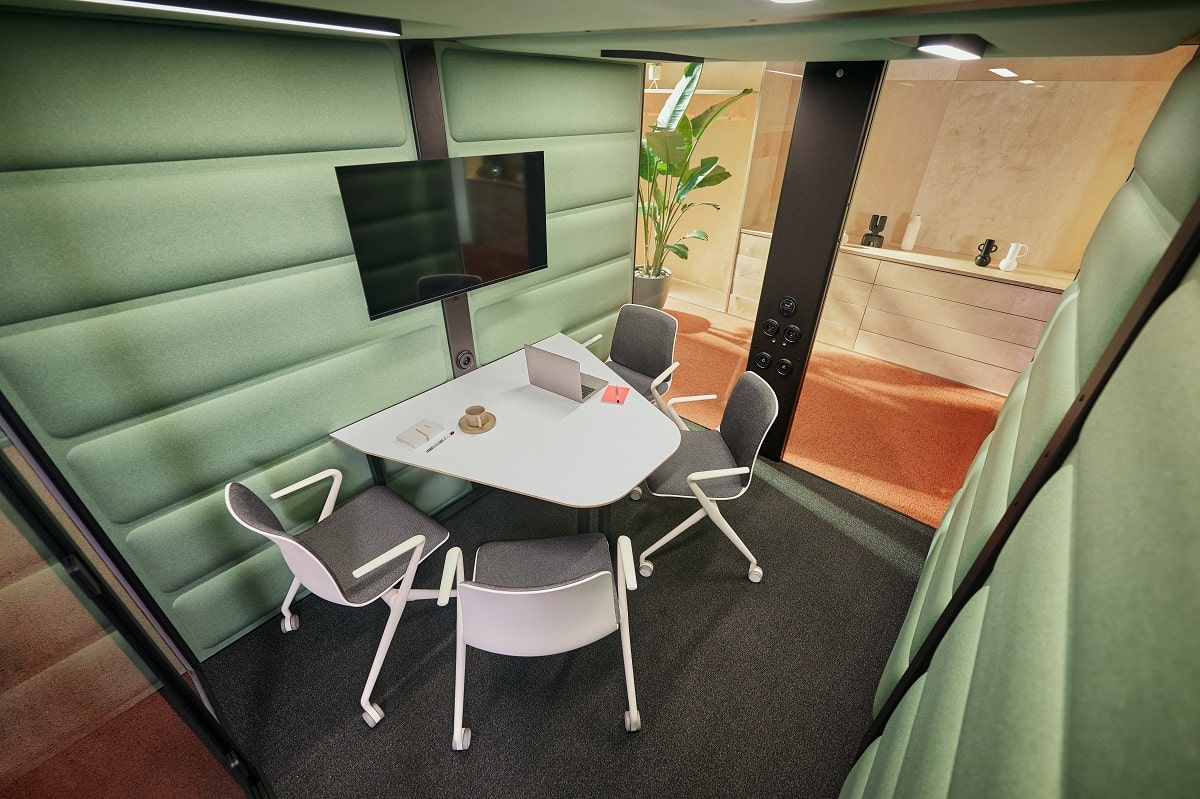
Cognitive overload…
Thinking in a second language requires more mental energy. This can lead to fatigue and reduced focus, especially in fast-paced environments. The faster-paced and noisier the environment, the greater the cognitive load. Insulating in a low-key, low-stimulus space like a booth can help.
Concentrating while speaking in a second language, a psychological affair.
The ability to hold attention during a non-native language based meeting is intricately influenced by several elements. All of these elements are worth a look when thinking over how to reboot your office space for more fluid, more productive cross-cultural collaboration.
Self-efficacy is crucial. Indeed, those with more confidence maintain stronger presence and engage more actively. Lower self-efficacy makes for hesitation and haziness. For this, private practice in a private space can help greatly. Then there is the reality that speaking in a foreign tongue, particularly complex or unfamiliar topics, is mentally taxing. Here we see why getting a handle on the office’s balance of bustle and hush is so important — so that employees aren’t burnt out by office hubbub before even signing onto a key meeting. Lastly, interpreting non-verbal cues like body language and facial expressions adds another layer of cognitive demand. For video calls, the need for excellent lighting becomes apparent
– says Mateusz Barczyk, Senior Brand Manager, Hushoffice.
Noise and disturbances impair foreign language comprehension and communication.
Both are utter hindrances when working with a foreign language. In business settings, the ramifications of being sidetracked can be devastating within moments. Some scientific principles will help us fully appreciate the matter…
The brain regions involved in speaking a foreign language are particularly susceptible to office hubbub. The prefrontal cortex. It helps with learning language rules, constructing sentences, and processing unfamiliar sounds. Excessive noise and visual stimuli overload it. The broca’s area. Involved in speech production and language processing too. Background noise or conversations can disrupt its formation of coherent sentences in a non-native tongue. The parietal lobe. This one helps make out multiple inputs when communicating. Visual distractions like movements or cluttered environments can compete for attention and hinder its performance of linguistic tasks. Practically this means that to be friendly to multilingual employees and conducive to their best efforts, the office should offer peaceful sanctuaries like booths
– says Mateusz Barczyk, Senior Brand Manager, Hushoffice.
Cognitive load…
Every sensory stimulus contributes to cognitive load by diverting mental resources from processing and understanding a second language. The extra strain makes it harder to decode and retain new vocabulary and grammar structures.
Auditory processing challenges…
Ambient office noise is likely to interfere with auditory processing by masking or distorting spoken language. This distortion makes it difficult to distinguish between similar sounds or words, impeding accurate comprehension and pronunciation practice.
Reduced attention…
Background conversations and unpredictable noises all fragment attention. This disrupts the ability to maintain sustained attention on simple listening and language processing. Gaps in comprehension and retention follow.
Elevated stress…
Constant exposure to noise and other peripheral activities heightens stress levels, negatively affecting rudimentary cognitive functions like memory and attention.
Compromised listening skills…
In noisy offices, learners may not be able to pick up on language nuances or intonation patterns. This inevitably diminishes their ability to understand and produce natural-sounding speech.
Adapting the office for multilingual workers? Start by reducing distractions.
Thoughtful office design can greatly lower cognitive load. This gives multi-language employees the best possible environment for strong thinking and communication. And any reduction in cognitive strain allows for better concentration on complex language-related activities. In a quiet space, sophisticated tasks like producing multilingual content or speaking with an international client by phone for the first time can be carried out without interference or auditory clutter. The solutions toward this aim are rather simple. Soft acoustic treatments that reduce reverb. Mobile floor and desk partitions that isolate noise while cocooning small teams. Private booths like hushFree that give an ultimate sense of security and control over one’s space
– says Mateusz Barczyk, Senior Brand Manager, Hushoffice.
Closing recommendations. Catering to the varied language needs of your team.
Making workspaces work for multilingual meetings — and bilingual employees — is all about managing interruptions to create spaces where focus comes easily.
- Create soundproof or quiet areas where employees can complete language-intensive tasks without auditory distractions.
- Implement sound-absorbing materials like acoustic panels or partitions to reduce background noise in shared spaces.
- Offer a variety of workspaces (open areas, private rooms, collaborative spaces) to accommodate different communication and concentration needs.
- Provide small, private rooms for one-on-one conversations or language practice to reduce pressure and improve comprehension.
- Design informal breakout areas where employees can practice language skills in low-stress, collaborative settings.
- Equip meeting rooms with high-quality video conferencing systems that support clear audio for international meetings, ensuring participants can hear and understand speech clearly.
- Use natural lighting and minimal visual clutter to reduce stress and visual distractions, helping employees perform complex tasks like language processing.
HushFree booths. Premium spaces for language practice and international meetings.
They block out office noise for flowing conversation. Their padded interior eliminates reverberation, enhancing speech intelligibility. Their private, enclosed, stress-free space of minimized stimuli is simply ideal for focused language practice or complex multilingual discussions.
The hushFree.S video pod. Host international conferences without self-consciousness.
Self-consciousness diverts cognitive resources, increasing mental strain and harming one’s fluency. In hushFree.S, the employee is shielded from eavesdropping and other’s gazes. The pod’s insulation, adjustable lights, and adjustable ventilation foster natural focus.
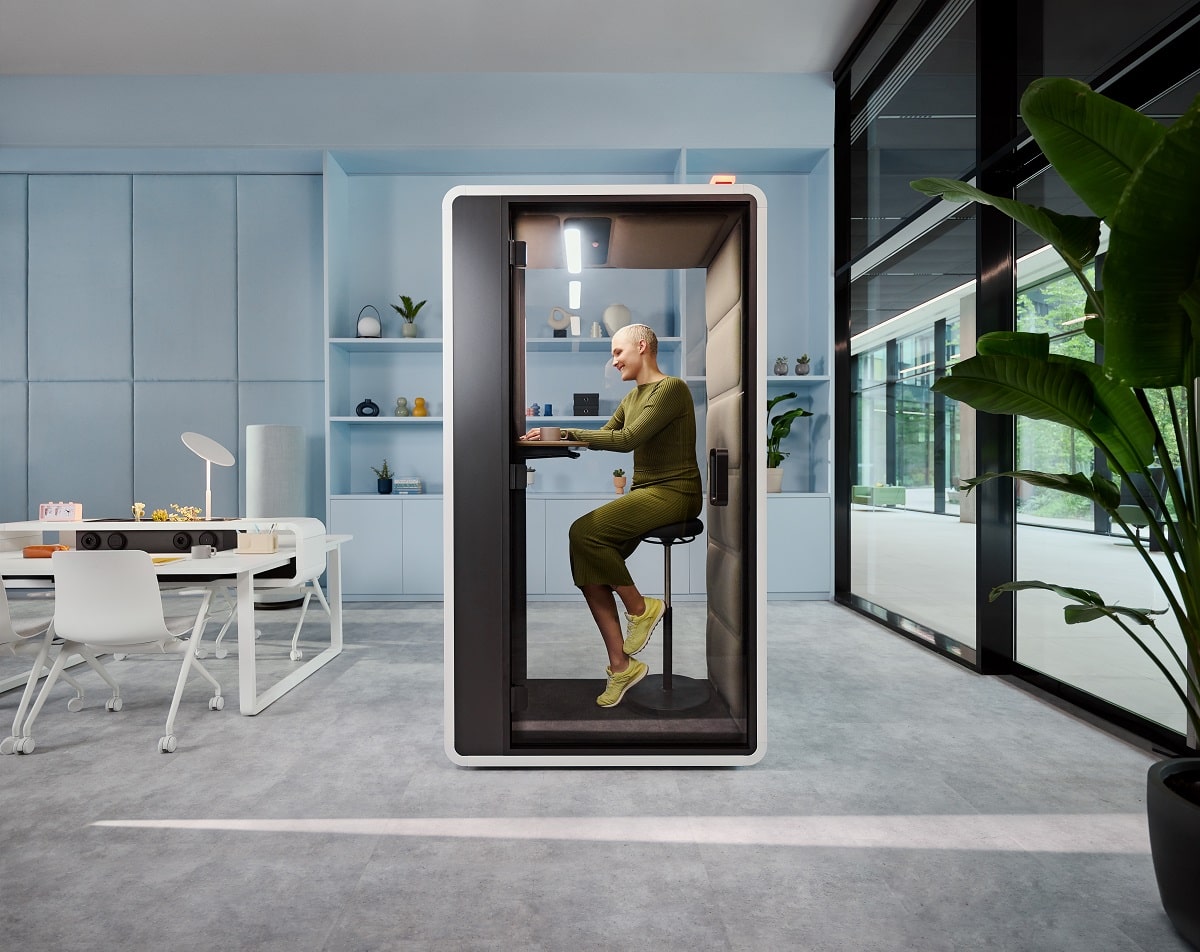
HushFree.M. An impeccable meeting space for visiting international clients.
HushFree.M blends comfort, professionalism, and acoustic discretion, giving every client the right impression. Equipped with cozy sofas and a convenient meeting table, the 4-person booth guarantees privacy during critical discussions, giving clients the assurance of security.
HushFree.L. A relaxed space for small-group language study.
Privacy is so very beneficial for group language practice without the anxiety of public spaces. Depending on how it is furnished, hushFree.L seats between 4-6 people. Cozy, casual, and acoustically sound, the spacious booth makes a terrific practice room for language work.
Break down barriers with the help of hushFree booths
The neutral design of a hushFree booth not only accommodates diverse tastes and cultural preferences but also eliminates visual noise. This helps to ensure that the attention is on the dialogue rather than the surroundings. Such simplicity can play a big role in breaking down barriers, removing unnecessary elements that could detract from understanding. Moreover, their noiselessness is terrifically beneficial in international meetings, where the cognitive demand of speaking or listening in a non-native language is already large. And lastly, their ergonomic design and climate-controlled interiors keep participants physically at ease through long meetings. Feeling comfortable and secure, clients are better able to engage and collaborate regardless of language or cultural differences
– says Mateusz Barczyk, Senior Brand Manager, Hushoffice.
Multilingual meetings – summary
- Multilingual employees are integral to an international company’s business. They lead quality dialogue, allow for attentive customer service, and bridge gaps within global teams. However, speaking a foreign language is always difficult due to factors like fear of judgment, difficulty expressing nuances, and mental exhaustion.
- Distractions, noise, and environmental stressors all further impair comprehension and communication in a second language. Acoustic booths like hushFree address these issues. They provide soundproof, quiet environments that enhance speech intelligibility while reducing cognitive strain.
- Acoustic pods and booths make premium spaces for dedicated language practice as well. By eliminating visual and auditory noise, they function as stress-free, judgment-free zones for group practice.
Multilingual meetings – frequently asked questions
How can offices be designed to minimize distractions for multilingual meetings?
Acoustic panels, mobile partitions, and private booths help by reducing noise and visual clutter.
What is cognitive overload, and how does it affect multilingual employees?
Cognitive overload occurs when the brain is overwhelmed by too many sensory stimuli, making it difficult to process information. For multilingual employees, this spells mental fatigue and a hazy focus. Sound-insulated private booths like hushFree can help by providing a quiet, calming space for employees to recover from burnout.
How distractions affect language comprehension and communication?
In short, they overwhelm cognitive resources. This creates difficulty processing and understanding a second language. As listening skills are compromised, attention is reduced, and stress is increased, for communication to suffer.
